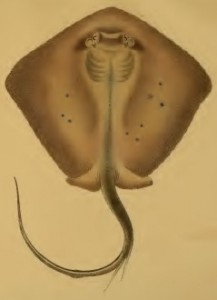WA classifies black and smooth stingrays as protected fish in the South West
Media Release
Department of Fisheries, Western Australia
28. January 2015
————————-
Two stingray species now protected in the South West
 New regulations have now come into force to classify two stingray species – black and smooth stingrays – as protected fish, in both the West Coast and South Coast Bioregions of WA.
New regulations have now come into force to classify two stingray species – black and smooth stingrays – as protected fish, in both the West Coast and South Coast Bioregions of WA.
These regions cover the Western Australian coast from the Zuytdorp Cliffs, north of Kalbarri, through to the South Australian border and it is in these waters that the two stingray species (Dasyatis thetidis and Dasyatis brevicaudata) will no longer be able to be taken by fishers.
If caught, these stingrays must be returned to the water as soon as possible.
Department of Fisheries’ Aquatic Biodiversity Branch Team Leader, Dr Shaun Meredith said the new rule recognised the residential and inquisitive (often placid) nature of stingrays, which in some coastal towns have become valued by their local communities.
“Black and smooth stingrays tend to be the main species that aggregate around fish cleaning stations, which is why they have now become protected in the West and South coast bioregions,” Dr Meredith said.
“Hamelin Bay is already a protected area for all ray and skate species, but this change now gives protection to black and smooth stingrays, at other popular interaction areas, and the department has worked closely with Recfishwest in developing this new regulation.”
Recfishwest Chief Executive Officer, Dr Andrew Rowland said fishers acknowledged the tourism and conservation value of large tame residential stingrays particularly in holiday locations; such as the Hardy, Walpole and Nornalup Inlets on the South Coast and along the West Coast, in areas such as Rottnest Island, Lancelin and Jurien Bay.
“Having the opportunity to see and interact with large stingrays at close quarters while out fishing adds to the overall enjoyment of the outdoor experience,” Dr Rowland said.
“Recreational fishers support protecting these species and their associated values.”
Dr Meredith said rays played an important role in the marine ecosystems as scavengers and predators and the public’s fascination with the winged wonders of the sea was reflected in their popularity with many residents who live on the coast and tourists who visit WA’s stingray aggregation areas.
“These new regulations ensure the most commonly seen species are protected along the State’s West and South coasts,” he said.
Source: Government of Western Australia
